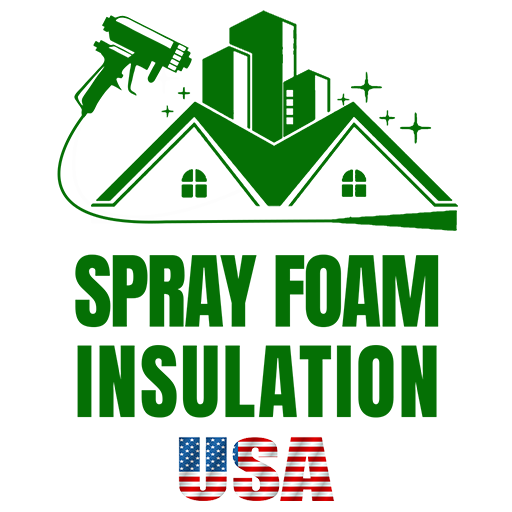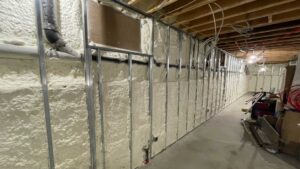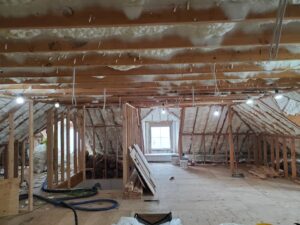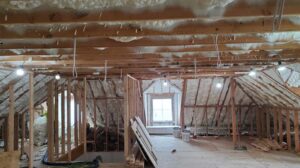Quick Guide to Attic Insulation Solutions:
- Energy Efficiency: Reduce your heating and cooling needs by properly insulating your attic.
- Comfort Enhancement: Keep your home’s temperature stable and comfortable year-round.
- Cost Savings: Lower your energy bills by improving your attic’s insulation.
When you’re seeking out attic insulation solutions, you’re probably looking to achieve three major goals: improving energy efficiency, enhancing comfort, and saving on energy costs. If these are on your list, you’re on the right track. An efficiently insulated attic can significantly reduce the need for heating in the winter and air conditioning in the summer, making your home not only more comfortable but easier on your wallet and the environment.
Insulation acts like a cozy blanket for your home. It hampers heat from escaping in the cold months and blocks it from entering during the summer. This simple idea can make a big difference. A well-insulated attic helps maintain a more consistent indoor temperature, ensuring your living space is more inviting, no matter the season outside. Plus, by cushioning your home against the whims of the weather, insulation minimizes your household’s energy consumption. This reduced demand for heating and cooling translates not just to monetary savings, but to a lighter environmental footprint as well.
But the benefits don’t end there. Good insulation also means quieter living spaces, less strain on your HVAC systems, and a potential increase in your home’s value. Whether you’re a homeowner in the vibrant streets of New York or the scenic sprawls of New Jersey, understanding the various attic insulation solutions available to you is the first step towards achieving a more energy-efficient, comfortable, and cost-effective dwelling.

Understanding Attic Insulation
When we talk about making our homes more energy-efficient, attic insulation is a key player. Let’s dive into why it’s so important and how it works.
Thermal Energy Flow
Imagine your home as a giant coffee cup. In winter, you want to keep the heat (your coffee) inside as long as possible. In summer, you’re trying to keep the heat outside, so your home stays cool. Thermal energy flow is basically the movement of heat in and out of your house. Without proper insulation, your heating and cooling system has to work overtime, which costs you money and comfort.
Building Envelope
Your home’s building envelope includes the walls, roof, windows, and doors – essentially, the parts of your house that separate the interior from the exterior. Think of attic insulation as a critical part of your home’s winter coat. If the coat is too thin (poor insulation), heat escapes easily, and your home gets cold. Similarly, in summer, a good coat keeps the heat outside, so your home stays cooler.
R-value Significance
The R-value is a measure of how well insulation can resist heat flow. Higher R-values mean better insulation. For your attic, a high R-value is crucial because heat rises. In winter, you don’t want your warm air escaping through the attic. In summer, you don’t want the sun’s heat turning your attic into an oven that then heats the rest of your home.
The key takeaway? The right attic insulation can make a huge difference in your home’s energy efficiency, comfort, and utility bills. Whether you’re in the sweltering heat of summer or the bitter cold of winter, good attic insulation keeps your indoor temperature more stable, which means your heating and cooling systems don’t have to work as hard. This not only saves you money but also extends the life of your HVAC system.
Understanding these basics about attic insulation helps homeowners make informed decisions about how to best insulate their homes, leading to a more comfortable, energy-efficient living space. In the next sections, we’ll explore different types of attic insulation solutions and how to choose the right one for your home.
Types of Attic Insulation
When it comes to making your home more energy-efficient, choosing the right type of attic insulation is crucial. Let’s dive into the most common types of attic insulation solutions: Fiberglass, Cellulose, Loose-fill, and Spray foam.
Fiberglass Insulation
Fiberglass comes in two main forms: batts and rolled. This type of insulation is made from fine glass fibers and is one of the most commonly used insulations due to its cost-effectiveness and ease of installation.
- Pros: It’s relatively inexpensive and provides good thermal resistance. It’s also non-flammable and resistant to moisture damage.
- Cons: It can be irritating to the skin and lungs during installation, and it may not provide a complete air seal.
Cellulose Insulation
Cellulose Insulation is made from recycled paper that’s treated with boric acid to resist fire, pests, and mold. The most common installation method is the wet-spray method, which helps control dust and increase the insulation value.
- Pros: It’s eco-friendly and provides excellent thermal performance. It can also be easier to install in attics with irregular shapes.
- Cons: It can settle over time, potentially reducing its effectiveness. It’s also a bit more expensive than fiberglass.
Loose-Fill Fiberglass
Loose-Fill Fiberglass is similar to fiberglass batts but in a loose form that is blown into the attic. This method covers the attic floor with a fluffy layer of insulation and is particularly effective in attics with lots of nooks and crannies.
- Pros: It can fill in more gaps and spaces than batts, providing a more thorough coverage.
- Cons: It may not perform as well in extremely cold temperatures. It also requires a special machine to install.
Spray Foam Insulation
Spray Foam Insulation comes in two types: closed-cell and open-cell. It’s sprayed into place, where it then expands and hardens, creating an effective air barrier and moisture barrier.
- Pros: It provides an excellent air seal, improving energy efficiency significantly. It can also add structural strength to your home.
- Cons: It’s the most expensive option and must be installed by professionals. It can also off-gas volatile organic compounds (VOCs) during the curing process.

Each type of insulation has its own set of advantages and disadvantages. The best choice for your home will depend on factors like your budget, climate, and specific needs for moisture control, air sealing, and R-value.
In the next section, we’ll address common attic insulation questions, helping you further narrow down the best attic insulation solution for your home.
Choosing the Right Insulation for Your Attic
When it comes to upgrading your attic insulation, you’re faced with a buffet of choices. Each option has its own set of pros and cons, tailored to different needs and preferences. Let’s dive into how you can pick the perfect fit for your attic, focusing on cost-effectiveness, installation method, attic size, and whether to DIY or hire a professional.
Cost-effectiveness
Not all insulation is created equal, especially when it comes to your wallet. Fiberglass batts might be light on the budget upfront but consider their long-term effectiveness. On the other hand, spray foam insulation might have a higher initial cost but can provide substantial savings on energy bills down the line. It’s a balancing act between upfront costs and future savings.
Installation Method
Your chosen insulation’s installation method can greatly influence your decision. Fiberglass batts and rolled insulation are more DIY-friendly. They can be simply rolled out and fitted into place. However, loose-fill and spray foam require specialized equipment and knowledge for proper installation. The complexity and time involved in the installation process are key factors to consider.
Attic Size
The size and layout of your attic play a significant role in choosing the right insulation. Large, open attics might be easier to work with when using loose-fill fiberglass or cellulose, as these materials can cover large areas quickly and efficiently. Smaller or more irregularly shaped attics might benefit from spray foam insulation, which can easily get into tight nooks and crannies, ensuring a thorough job.
DIY vs. Professional
Deciding whether to tackle attic insulation as a DIY project or to hire professionals depends on several factors. If you’re comfortable moving around in your attic and handling the installation process, fiberglass batts or rolled insulation might be within your reach. However, for more complex solutions like spray foam, professional installation ensures that the job is done right the first time, avoiding costly mistakes or inefficiencies.
Pro tip: Always wear protective gear, regardless of the insulation type you’re working with. Safety first!
In conclusion, the right attic insulation solution for your home hinges on a blend of factors including cost, installation method, attic size, and personal capability for DIY projects. Taking the time to assess your specific situation will lead you to the most effective, efficient, and economical choice for your attic insulation needs.
As we move into the next section, we’ll tackle some common attic insulation questions to help you further refine your decision, ensuring your home is cozy, energy-efficient, and well-protected against the elements.
Addressing Common Attic Insulation Questions
When it comes to attic insulation, several questions frequently arise. Let’s dive into these and provide clear, straightforward answers.
What is the most effective attic insulation?
The effectiveness of attic insulation is measured by its R-value — the higher, the better. Fiberglass, cotton, and mineral wool are all popular choices, each with its own benefits.
- Fiberglass is widely used due to its affordability and effective thermal resistance.
- Cotton, often made from recycled denim, is an eco-friendly option that also provides good insulation.
- Mineral wool has a higher R-value per inch compared to fiberglass and cotton, making it extremely effective for thermal insulation and also offers excellent fire resistance.
Which is better: blown or rolled insulation?
Choosing between blown and rolled insulation depends on your specific needs and the area you’re insulating.
- Rolled fiberglass is best for areas with uniform spacing between joists and studs, as it can be easily laid out in sheets.
- Blown fiberglass is more effective in covering irregular spaces and achieving a higher overall R-value since it can fill nooks and crannies more completely.
In summary, if you have a standard, easy-to-access attic, rolled might be the way to go for a DIY project. For attics with irregular spaces or hard-to-reach areas, blown insulation, although it might require professional installation, will provide better coverage.
Can you put too much insulation in your attic?
Yes, there is such a thing as too much insulation, and it can lead to several problems:
- Humidity issues: Excessive insulation can trap moisture in the attic, leading to high humidity levels.
- Mold growth: With high humidity comes the risk of mold, which can damage your home and create health problems.
- Water damage: Inadequate ventilation combined with trapped moisture can result in water damage to the attic structure and the rest of the home.
To avoid these issues, it’s crucial to strike the right balance in insulation thickness and ensure proper attic ventilation. This balance will help maintain a healthy, efficient, and safe home environment.
By understanding the pros and cons of different insulation types and how much to use, you can make informed decisions that enhance your home’s energy efficiency and comfort. If you’re unsure, consulting with a professional can provide personalized advice tailored to your home’s specific needs.
As we look towards enhancing energy efficiency with specific solutions, the right choice in attic insulation not only contributes to a more comfortable and sustainable home but can also offer significant savings on energy bills over time.
Enhancing Energy Efficiency with Spray Foam Insulation USA
When we talk about making our homes more energy-efficient, it’s crucial to focus on solutions that not only save energy but also respect our planet. That’s where Spray Foam Insulation USA comes into play. With a keen eye on eco-friendly solutions, services catering to both the commercial and residential sectors, and a commitment to sustainable services, they’re leading the charge in making our living and working spaces better for the environment and our wallets.
Eco-Friendly Solutions
Spray Foam Insulation USA understands the importance of reducing our carbon footprint. Their attic insulation solutions are designed with the environment in mind. By using products that have a low environmental impact and are made from recycled materials, they ensure that your home insulation is not just effective but also kind to the planet.
One standout feature is their use of spray foam insulation. This material acts as an air barrier, which means it can effectively seal cracks and gaps. This sealing capability minimizes the need for heating in winter and cooling in summer, leading to less energy consumption. Plus, the materials used for spray foam are selected for their eco-friendly properties, ensuring that your insulation upgrade is a green choice.
Commercial and Residential Sectors
Whether you own a small home or run a large commercial facility, Spray Foam Insulation USA has the expertise to tackle any project. In the residential sector, they offer solutions that make homes more comfortable and energy-efficient, leading to lower utility bills and a reduced environmental impact.
In the commercial sector, their services help businesses reduce their operational costs by improving their buildings’ energy efficiency. This not only helps companies save money but also contributes to their corporate social responsibility efforts by reducing their carbon footprint.
Sustainable Services
Sustainability is at the heart of Spray Foam Insulation USA’s mission. They don’t just provide a one-time service; they offer sustainable insulation solutions that benefit their customers for years to come. By improving a building’s insulation, they ensure that less energy is needed to maintain comfortable temperatures, which in turn reduces the demand on fossil fuels and lowers greenhouse gas emissions.
Moreover, Spray Foam Insulation USA is committed to continuous improvement in their practices, staying up-to-date with the latest in green technology and sustainable materials. This commitment means that when you choose them for your attic insulation needs, you’re not just getting a service. You’re investing in a solution that will keep your home or business energy-efficient and eco-friendly for the long haul.
As we move into the next section, it’s clear that choosing the right insulation for your attic is more than just a practical decision—it’s a step towards a more sustainable future. Let’s explore how Spray Foam Insulation USA can help you make that step with confidence and ease.
Conclusion
Taking the Next Step Towards Energy Efficiency
Congratulations on making it this far! You’re now armed with valuable information about attic insulation solutions, and you’re almost ready to take action. But, before you do, let’s talk about two critical steps that will ensure your journey towards a more energy-efficient home is smooth and successful: the energy audit and exploring financing options with Spray Foam Insulation USA.
Energy Audit: Your First Move
An energy audit is like a doctor’s check-up for your home. It’s a comprehensive examination of how your home uses (and loses) energy. This step is crucial because it helps us pinpoint exactly where your home needs improvement. Think of it as creating a roadmap for enhancing your home’s energy efficiency.
During the audit, a professional will inspect your attic, walls, windows, doors, and HVAC systems. They’ll look for leaks, inadequate insulation, and other issues that could be causing energy loss. The goal? To identify every opportunity to boost your home’s efficiency, comfort, and safety.
Financing Options: Making It Affordable
We understand that upgrading your home’s insulation is an investment. That’s why at Spray Foam Insulation USA, we offer various financing options to make this necessary improvement more accessible. Whether you’re interested in our “12 months same-as-cash” financing or a longer-term plan, we have options designed to fit your budget. A $5,000 project, for example, could cost as little as $99/month. We believe that everyone deserves a comfortable, energy-efficient home, and we’re here to help make that a reality for you.
Why Choose Spray Foam Insulation USA?
Choosing Spray Foam Insulation USA means you’re not just getting attic insulation solutions; you’re getting a partner in making your home the best it can be. We’re dedicated to offering eco-friendly solutions that don’t just save you money on energy bills but also contribute to a healthier planet. Our team of experts is committed to providing both commercial and residential sectors with sustainable, high-quality services.
Insulation isn’t just about keeping warm in the winter or cool in the summer. It’s about creating a consistent, comfortable environment in your home year-round, reducing your carbon footprint, and ultimately, enhancing your quality of life.
Ready to embark on a journey towards a more energy-efficient and comfortable home? Contact Spray Foam Insulation USA today for a free estimate. Let us be your guide to a greener, more sustainable future.
With Spray Foam Insulation USA, take the first step towards a more energy-efficient home. Learn more about our services and how we can help.
Your comfort, our mission. Let’s make your home the best it can be, together.





